Mexican Bean Beetles: Identification, Damage and Control (With Pictures)
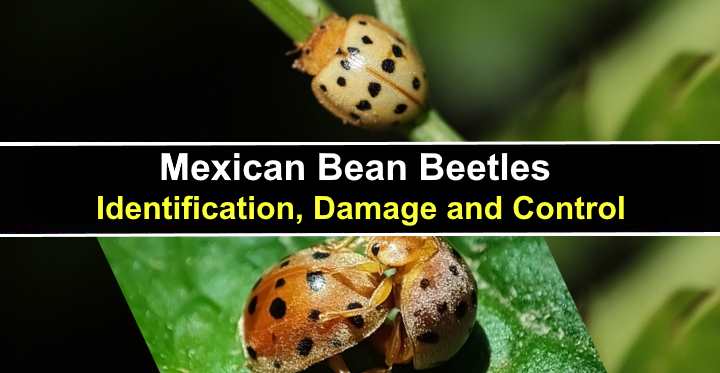
The Mexican bean beetle is a small orange-brown winged insect that looks like an oval shaped ladybug with sixteen black spots arranged in three rows. The adult Mexican bean beetles measure 0.23” to 0.27” long (6 – 7 mm).
The Mexican bean beetle is a serious pest in vegetable gardens that can damage the leaves of legume crops, including snap beans, lima beans, soybeans, peas and lentils.
The best way to get rid of Mexican bean beetles is to prevent them from infesting your garden. However, natural insecticides can also help kill these pesky plant-eating orange insects.
Mexican bean beetles can be identified by their black-spotted brown-orange appearance that contrasts against the dark green foliage of bean plants. But their eggs and larvae on leaf undersides can go undetected until the small orange lady beetles emerge or you notice leaf damage on your legume plants.
What can you do if you notice small beetles that look like black spotted orange ladybugs crawling on the surface of leaves? Or maybe you have noticed leaves becoming skeletonized, and you want to eradicate Mexican bean beetles from your vegetable plot. In that case, this article provides solutions to your problems.
This Mexican bean beetle identification guide helps you spot these pesky flying bugs in the garden. You will also learn how to differentiate between Mexican bean beetles and ladybugs. Finally, at the end of the article, you will get helpful tips on eradicating these orange-brown beetles from your yard.
What Are Mexican Bean Beetles (Epilachna varivestis)?
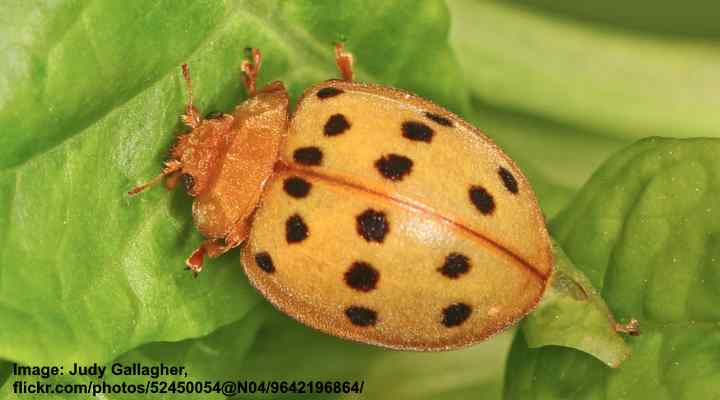
The Mexican bean beetle is a type of black spotted brown-orange colored lady beetle that causes damage to the leaves of legume crops
The Mexican bean beetle is a leaf-eating brown lady beetle species in the genus Epilachna. The adult Mexican bean beetle beetle is identified by its oval-shaped elytra (wing covers), dull orange color, and sixteen black spots on its back arranged in three rows.
Mexican Bean Beetle Facts
Mexican bean leaf beetles are native to the southern region of Mexico. The beetles were introduced to North America in the early part of the 20th Century and are active in most states east of the Rocky Mountains. However, unlike their destructive activity in the US, they are not crop pests in their native habitat.
The adult beetle and the larvae feed on young bean pods and plant stems, sucking the juice out of bean plants and causing them to wither and die. The plant-destroying beetles are most active in July and August. In some states, the pesky insects do as much damage as Japanese beetles or potato beetles.
Mexican bean beetles look like orange ladybugs. However, unlike the native lady beetles (genus Coccinella), which are beneficial insects, bean leaf beetles are destructive pests.
Mexican Bean Beetle Identification
Mexican bean beetle adults measure 0.23” to 0.27” long (6 – 7 mm). Therefore their small size can make them difficult to spot. However, on leaf surfaces, the bright orange color and black spots make the lady beetles relatively conspicuous and easy to identify.
Mexican bean beetles are more difficult to identify in the egg or larval stage. The yellow eggs measure just over 0.04” (1 mm) and are in clusters of around 75 eggs on the underside of leaves. The beetle’s larvae emerge 0.06” (1.6 mm) in size and grow to 0.37” (9.5 mm).
Mexican Bean Beetle vs. Ladybug
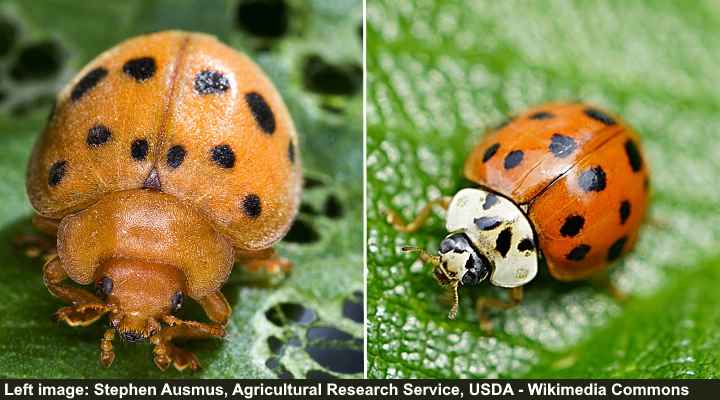
Mexican bean beetle (left) vs. Asian lady beetle /Japanese ladybug (right)
It’s easy to mistake a Mexican bean beetle for a typical ladybug. The difference between the two species is the number of black spots on the elytra—Mexican ladybugs always have 16. In contrast, native ladybugs have varying numbers of spots. Additionally, unlike native ladybugs, the invasive beetles don’t have markings on their thoraxes.
The Mexican bean leaf beetle and ladybugs are significantly different in their eating habits. Lady beetles are carnivorous and feed on small bugs like aphids. However, Mexican bean beetle adults are plant-feeding lady beetles. This difference makes them a pest wherever bean plants are growing.
Habitat of the Mexican Bean Beetle
The Mexican bean beetle is a pest in the eastern United States. The small flying orange beetle insects are found from the Great Lakes to the Gulf of Mexico and east to Florida and New England. The nasty plant-eating beetles can also destroy legume crops as far north as Ontario and Quebec.
Mexican Bean Beetle Life Cycle
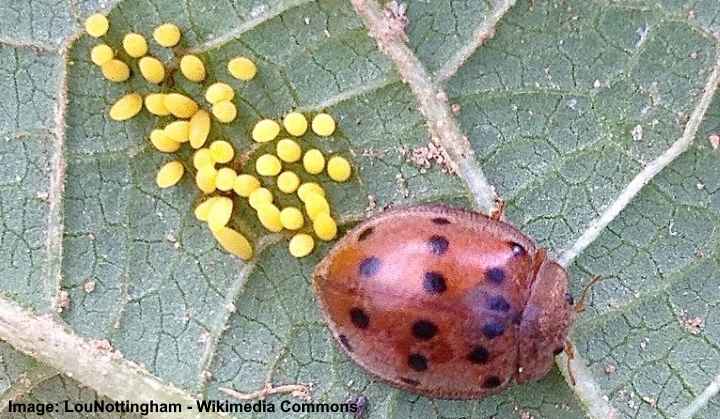
Mexican bean beetle laying eggs
The Mexican bean beetle starts life as a tiny pale yellow or orange-yellow egg measuring 0.6” (1.6 mm) long and 0.2” (0.6 mm) wide. The female lays eggs in late spring in clusters of 40 to 75 eggs on the underside of plant leaves in the family Fabaceae.
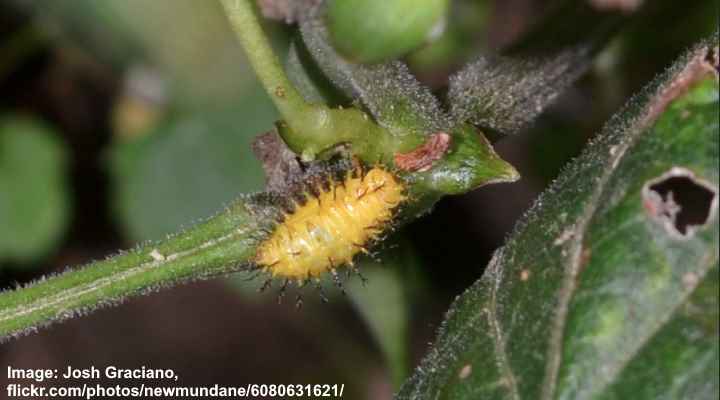
Mexican bean beetle larva
The egg stage lasts two weeks, after which yellow spine-covered larvae emerge on leaf undersides. The hungry pests grow up to 0.37” (9.5 mm) long. During the larval stage, the tiny “bugs” gorge on bean plant leaves, causing considerable damage.
After the pupal stage, adult bean leaf beetles emerge. During the adult stage, the beetle turns from straw-yellow to orange-brown and has its characteristic eight black spots on each elytron. The beetles overwinter in sheltered, moist places and remain dormant until the following spring.
What Do Mexican Bean Beetles Eat?
As their name suggests, legumes and peas are common host plants for Mexican bean beetles. Favorite items on the beetle menu are snap beans, soybean leaf, runner beans, lima beans, green beans, string beans, and cowpeas. However, they will also consume foliage on most legume plants and attack ornamental plants like wisteria and lupines.
Mexican Bean Beetle Plant Damage
Mexican bean beetles damage plants by sucking the sap from leaves. As a result, the hungry beetles only consume soft plant tissue between the leaf veins. This feeding habit causes leaves to have a skeletonized appearance and become wilted or discolored. In some cases, the destructive pests feed on flowers and small pods.
Mexican bean beetle larvae cause more damage than adults. The tiny spiny creatures cling to the underside of leaves, eating irregular sections of leaf tissue. This feeding habit results in discoloration of the upper side of the leaf, causing it to dry out and develop a lace-like appearance.
In some cases, a large number of bean leaf beetles can cause severe economic damage due to crop loss.
How to Spot Mexican Bean Beetle in a Vegetable Patch
The easiest way to spot the tell-tale signs of Mexican bean beetle activity is by leaf damage. You may notice that the leaves of bean and pea crops appear discolored and may start to develop small holes. In time, the damage is more extensive, and the leaves have a lacy appearance.
How to Control Mexican Bean Beetle
The best way to control Mexican bean beetle activity is through integrated pest management. This garden pest control approach combines a variety of methods, including hand picking, natural insecticides, crop rotation, and other cultural controls.
Here are several ways to eradicate Mexican bean beetles from your garden.
Hand-pick Mexican bean beetles
The easiest way to kill Mexican bean beetles for good is to hand-pick the eggs, larvae, and adult beetles. Therefore, regularly checking the undersides of bean plant leaves from early spring through June is a good idea. Look for clusters of tiny yellowish eggs or small larvae sticking to the leaves.
To kill beetle eggs and larvae, you can use a cloth with an insecticidal soap solution and wipe the eggs and larvae. The effect of the fatty acids in the soap is enough to kill the soft eggs and larvae on contact.
If you notice orange ladybugs with 16 spots on their backs, you can remove them from the plant leaves and drop them into a bucket of soapy water. This beetle control method is most effective when a few bean leaf beetles are in your vegetable patch.
Beneficial insects feed on Mexican bean beetle larvae
Introducing Mexican bean beetle predators can be an effective method of reducing their numbers. Beneficial insects like ladybugs, minute pirate bugs, and green lacewings feed on beetle eggs and larvae. Additionally, parasitic insects lay eggs in bean leaf beetle larvae and kill them before they can do extensive damage.
According to comprehensive research, one of the most effective biological control methods for Mexican bean beetles is the parasitic wasp Pediobius foveolatus. Studies show that these non-stinging adult wasps lay eggs in beetle larvae. When the wasp larvae hatch, they kill the host larvae. Researchers found that releasing the wasps at seven to ten-day intervals helps to control bean leaf beetle numbers.
When using biological control to kill destructive pests, it’s vital to remember and release the insects early in the season. Predatory insects don’t affect adults—they must be able to lay eggs in larvae for this method to be effective on vegetable crops.
Diatomaceous Earth
Diatomaceous earth (DE) is a non-toxic insect control method that doesn’t harm the environment. For example, DE controls bean beetles because it’s an abrasive white substance that cuts through the soft bodies of larvae. This effect causes the larvae and adult beetles to dehydrate, develop respiratory problems, and die.
The good news is that food-grade diatomaceous earth is non-toxic to pets and humans.
However, there are specific ways to use DE to be effective for beetle control. For example, it only works when the ground and leaf foliage is completely dry. Also, you must reapply the white powdery substance after rainfall or watering the garden.
In addition to using DE, you could prevent egg laying by applying kaolin clay to seedlings and young plants. This natural substance can help to deter adult beetles from laying eggs on plants.
Insecticidal soap to eradicate Mexican bean beetles
Insecticidal soap is a great way to eradicate Mexican bean beetles. The fatty acids affect the protective coating on larvae and insects. This then breaks down the cell membrane, and the orange bugs die. Buying a commercial product that only contains natural ingredients is the best way to use insecticidal soap for bug control.
To use insecticidal soap, liberally spray the solution on affected plants, making sure to drench the underside. Alternatively, you can soak a cloth with an insecticidal soap solution and wipe the eggs and larvae from the undersides of bean plant leaves.
Neem oil to kill Mexican bean beetle
Neem oil is one of the best organic methods for killing pesky insects that destroy plants. Neem oil contains an active ingredient, azadirachtin, which is a natural insect control measure. This acts as an insect repellent, reduces feeding, and interferes with the insect’s reproductive system, impacting its ability to lay eggs.
To make a homemade neem oil spray, mix two teaspoons of neem oil, one teaspoon of mild liquid soap, and a quart (1 l) of water in a spray bottle. Shake well to mix the ingredients. Spray the solution on affected plants every seven days until you notice the pests have disappeared.
Is there any scientific evidence to suggest that neem oil kills Mexican bean beetles?
One study on the effects of neem oil on insects in the family Epilachna found that it helps to reduce population numbers. Regularly applying neem oil to bean plants prevented the beetle larvae and pupae from reaching the adult stage. In addition, it impacted the feeding habits of adult bean leaf beetles.
How to Prevent Mexican Bean Beetles
Prevention is important in integrated pest control management when dealing with Mexican bean beetles. Prevention aims to reduce adult numbers, stop female beetles from laying eggs, and ensure healthy plants are resistant to pest infestations.
Here are several ways to control Mexican beetles in your garden.
Use row covers
Using row covers to protect young bean plants can prevent Mexican bean beetles from taking over your vegetable patch. In addition, floating row covers prevent adult beetles from laying eggs. The lightweight fabric allows sunlight through but keeps pesky insects out. Just ensure the sides are anchored in the ground.
When using row covers as a beetle-control method, removing the covers when the legume crops flower is vital. This allows pollination to occur, ensuring that beans and peas develop. After pollination when the bean pods start growing, you can keep the covers on until harvest.
Practice good crop management
Here are three effective ways to manage a vegetable patch and reduce the risk of beetle infestations.
Crop rotation: One way to reduce the risk of pest infestations in a vegetable garden is to practice crop rotation. Therefore, try to avoid planting legumes in the same place year after year. Instead, rotate crops and grow them in different areas each season. This will help disrupt the life cycle of Mexican bean beetles and prevent them from feeding on your crops.
Companion planting: Another way to repel Mexican bean beetles is to plant companion plants. These are varieties of vegetables and flowers known to have a repelling effect. Good plants to grow near bean crops include marigolds, nasturtiums, dill, chamomile, petunias, and rosemary. These plants will also help keep aphids and flea beetles away while attracting predatory wasps at the same time.
It could also be useful to plant alternating rows of beans and potatoes. Bean plants can help repel Colorado potato beetles, and the potato plants help keep bean leaf beetles away.
Annual garden cleanup: At the end of the season, remove all dead plants from the vegetable patch and compost them. Then till the soil in spring before planting. This helps to create an inhospitable environment for Mexican beetles and kills any overwintering insects in the soil.
Timed planting to prevent Mexican bean beetle damage
Suppose Mexican bean beetles are an issue in your area. In that case, you may consider planting early-season bean varieties or sowing beans later in the season. Beetle activity is at its peak in July. Therefore, planting as soon as the risk of frost has passed or in late summer means you may avoid the beetles when they are most active and destructive.
Related articles:
- How to Get Rid of Japanese Beetles
- Cucumber Beetles: Identification, Damage and Control
- Types of Beetles – Identification Guide
